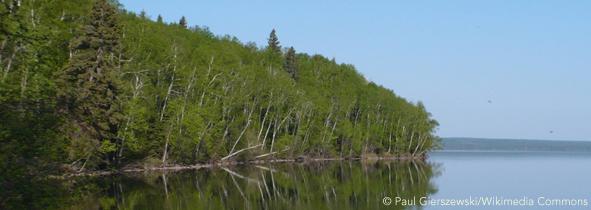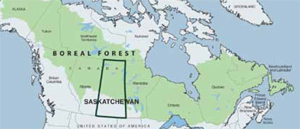Provincial and Territorial Forest Facts
Explore Canada's Boreal Forest by Province and Territory to see what makes each part of the boreal forest special.
Choose a province or territory:


Saskatchewan's Boreal Forest:
- is approximately 410,000 km2 (101 million acres) in size – larger than Germany.1
- comprises 7% of Canada's Boreal Forest.
- is home to more than 50 aboriginal communities.2
- is home to the Sharp-tailed Grouse, Saskatchewan's official bird, and the White (paper) birch, the official tree.
- stores 5 billion tonnes of carbon in its soils, peat and forests – equivalent to around 25 years' worth of Canada’s GHG emissions in CO2 equivalent at 2014 levels.3
- contains a portion of the 2,100 km-long (1,300 miles) Churchill River; the vast drainage basin of the river encompasses about half of the province's boreal forest.
- is the breeding ground for 70 to 200 million birds of more than 175 bird species, including Yellow Rail, Olive-sided Flycatcher, Bay-breasted Warbler and Rusty Blackbird.
- supports over 4,000, or 13%, of Canada's threatened boreal Woodland caribou population, as well as large populations of wolves, bear and other wildlife.4
- features 310,000 km2 (77 million acres) of intact forest, peatland and wetland habitat free from industrial development, making up 75% of the province's boreal region.5
1 Canadian Boreal Initiative. 2003. Canada's Boreal Region.
2 Aboriginal Canada Portal (www.aboriginalcanada.gc.ca), and Global Forest Watch.
3 Tarnocai, C. and Lacelle, B. 1996. Soil Organic Carbon Digital Database of Canada. Eastern Cereal and Oilseed Research Center, Research Branch, Agriculture and Agri-Food Canada, Ottawa, Canada.
4 Environment Canada. 2008. Scientific Review for the Identification of Critical Habitat for Woodland Caribou (Rangifer tarandus caribou), Boreal Population, in Canada. August 2008.
5 Global Forest Watch Canada. 2009. Canada's Forest Landscape Fragments: A Second Approximation.

